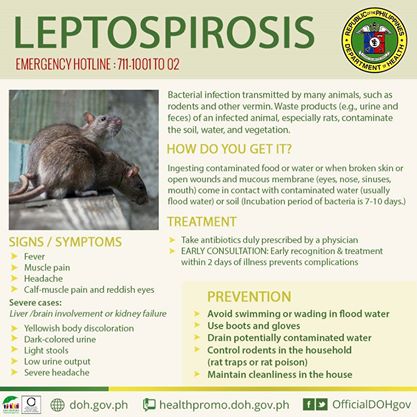The Philippines Department of Health (DOH) reports that the number of leptospirosis cases in the Metro Manila area is up more than 350 percent compared to last year.
According to Health Secretary Francisco Duque, urbanization, congestion and a lack of public awareness along with heavy rains and flooding can lead to increases in the bacterial infection.
DOH director for the National Capital Region (NCR) says 1,227 leptospirosis cases have been reported through the first nearly eight months. This is an increase of 358 percent compared to the same period in 2017.
Leptospirosis is a bacterial zoonotic disease caused by the corkscrew shaped organism, Leptospira. It goes by several other names depending on the locale; mud fever, swamp fever, sugar cane and Fort Bragg fever, among others. It is a disease of both humans and animals.

The rat is the main host to Leptospira. However, other animals such as cattle, pigs, horses, dogs, rodents, and wild animals can carry the bacterium.
People become infected by direct or indirect contact with the urine of these animals. Contact with urine-contaminated water is extremely important. Contaminated food and soil containing animal urine are other potential sources of infection.
The bacterium enters through contact with skin. Especially through cuts or breaks in the skin and through mucous membranes like the eyes.
Found worldwide, it was long considered an occupational disease (miners, farming, vets, and sugarcaneharvesting and sewer workers), it is increasingly associated with recreational water sports and camping.
Symptoms of leptospirosis, if present, appear in up to 4 weeks after exposure. Sometimes the person will show no symptoms or mild flu-like symptoms.
According to the CDC, leptospirosis may occur in two phases; after the first phase, with fever, chills, headache, muscle aches, vomiting, or diarrhea, the patient may recover for a time but become ill again. If a second phase occurs, it is more severe; the person may have kidney or liver failure (jaundice) or meningitis. This phase is also called Weil’s disease.
Leptospirosis is confirmed by laboratory testing of a blood or urine sample.
The infection can be treated with antibiotics (penicillin and doxycycline), especially if started early in the disease. For very ill patients, intensive care support and IV antibiotic may be necessary.
For more infectious disease news and information, visit and “like” the Infectious Disease News Facebook page
- Capillaria philippinensis: First described in the 1960s in the Northern Philippines
- Philippines reports increase in measles in 2018
- Philippines has the fastest growing HIV epidemic in Asia
- Philippines: January is Schistosomiasis Awareness month
- Philippines: Typhoons prompt advisory over typhoid, cholera, leptospirosis and hepatitis A


